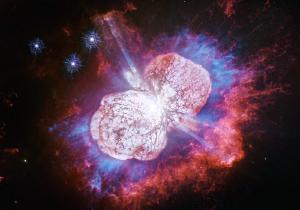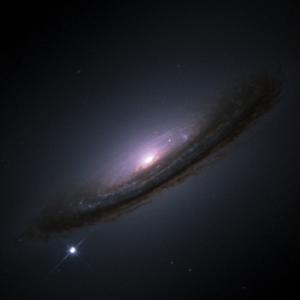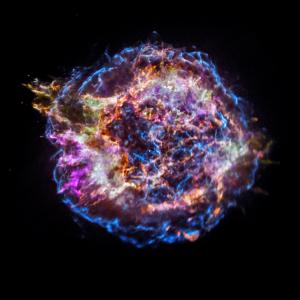Blog
Where’s the Kaboom?
10 September 2020
 NASA, ESA, N. Smith (University of Arizona, Tucson), and J. Morse (BoldlyGo Institute, New York)
NASA, ESA, N. Smith (University of Arizona, Tucson), and J. Morse (BoldlyGo Institute, New York)In October of 1604, a new star was seen in the night sky. It was the brilliant flash of a supernova that had exploded just 20,000 light-years from Earth. It was also the last supernova to be seen in our galaxy. In other galaxies, a supernova occurs about every fifty years. So why haven’t we seen one in the Milky Way for more than four centuries?
The lack of nearby supernovae in modern times has been an enormous disappointment for astronomers. If an event such as SN 1604 occurred today, we could study it with the full range of telescopes from radio to x-ray. A surge of neutrinos would stream through the world’s neutrino observatories, and gravitational waves would ripple through LIGO and VIRGO. A close supernova would provide a wealth of data and greatly enhance our understanding of these powerful events.
 NASA/ESA, The Hubble Key Project Team and The High-Z Supernova Search Team)
NASA/ESA, The Hubble Key Project Team and The High-Z Supernova Search Team)We know that supernovae are relatively common in other galaxies. Telescope observations of supernova have occurred regularly since the 1800s. Since then, we’ve observed more than 10,000 supernovae in other galaxies. So why don’t we periodically see supernovae in the Milky Way?
One idea is that while supernovae do happen, they occur in regions obscured by gas and dust. There is some evidence to support this. Cassiopeia A (Cas A) is a supernova remnant about 11,000 light-years away. It was first detected as a radio source in 1948. Based on the gas and dust motion in Cas A, it likely exploded around 1667, but there are no reports of a supernova from astronomers of that time. Galactic dust likely obscured visible light from the supernova, reducing its brilliance to that of a dim star.
 NASA/CXC/SAO
NASA/CXC/SAOHaving four centuries of supernovae obscured by dust would be quite a statistical fluke, so some astronomers have proposed that the supernova rate for the Milky Way is just unusually low. But this is contradicted by observations of radioactive isotopes in the galaxy. Gamma rays emitted by the decay of aluminum-26 show the aluminum isotope is being replaced by supernovae at about two per century.
It remains a mystery, but neutrino observatories should be able to answer it. A recent paper in New Astronomy looks at the theoretical rate of core-collapse supernovae.1 These supernovae produce a surge of neutrinos that can be detected by modern observatories. In 1987 one such supernova in the Large Magellanic Cloud triggered an observation. But to observe them in the Milky Way, neutrino detectors will need to operate for long times. On the order of a decade or so. Modern neutrino observatories can’t run for such extended times, so the technology will need to improve.
Until then, we’ll just have to hope that the next big kaboom is close enough to be visible in the night sky.
Rozwadowska, Karolina, Francesco Vissani, and Enrico Cappellaro. “On the rate of core collapse supernovae in the Milky Way.” New Astronomy (2020): 101498. ↩︎